The IMF yesterday downgraded its forecasts for global growth as well as its real GDP estimates for all the big economy regions. The organization now thinks GDP growth might have amounted to 2.9% last year. Not only the worst year since 2009, that was down from April 2019 approximations of 3.6% and the original forecasts which always start out near 4%.
Worse, estimates for this year are being trimmed. Though pretty much everyone has become more optimistic about the global economy, what does that really mean? The major models are starting to get the sense that it doesn’t quite mean what it is supposed to.
Global growth appears to have bottomed out but there is no rebound in sight and risks ranging from trade tensions to climate shocks makes the outlook uncertain, a top International Monetary Fund official said on Monday.
This seems to be the emerging consensus as the pendulum begins to swing back in the other (pessimistic) direction away from unchallenged optimism. From early September forward, renewed positivity had meant since the economy seemed to have avoided a worse fate it would immediately start to get better. Having emerged from recession’s shadow, right back to growth and booms again.
But that’s not quite how it’s gone, nor does it appear like it will turnaround soon. At some point the turnaround must turn around. The longer it goes without, the more questions will be raised.
Has the economy actually reached its bottom?
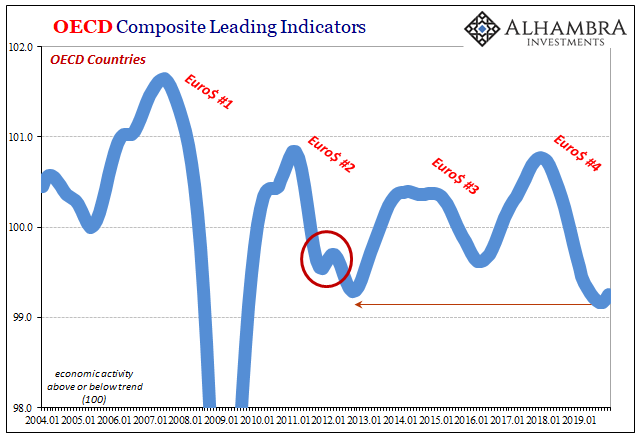
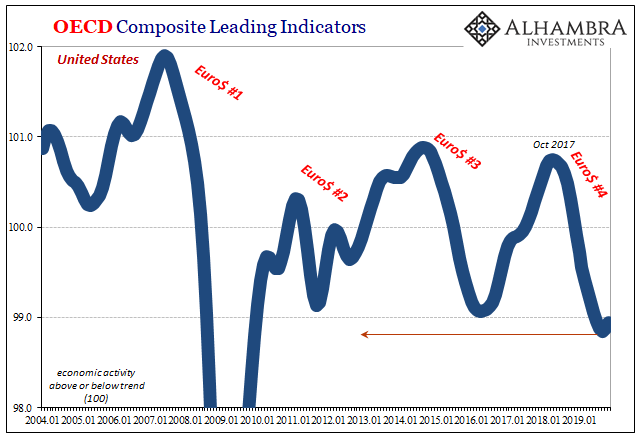
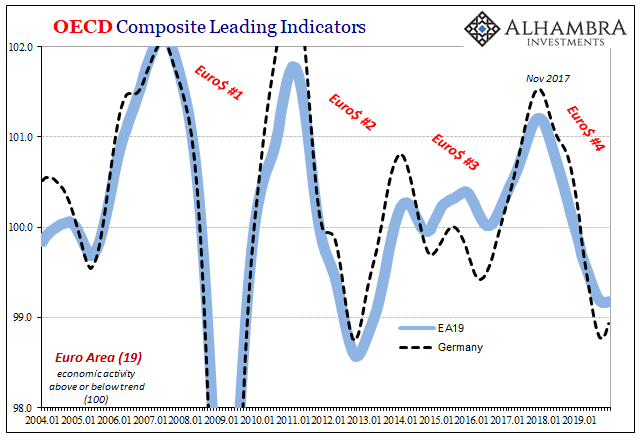
Indications like the OECD’s Composite Leading Indicators (CLI) are a big reason why it has been assumed the economy has. In nearly every case (except those like Japan), CLI figures make it look like the trend has plumbed its ultimate depth and even if it’s not heading too far too fast in the right direction at least it’s not getting worse.
By looking at the charts, it seems a reasonable assumption; once the leading indicators turn around, everything turns around thereafter.
But these are preliminary estimates and more so being moved by the changes in the various yield curves around the world. If it turns out that the world is misreading the bond market’s signals, and the global economy does take another leg lower, then these numbers will all be revised.
What today looks like the modest first steps in the formation of a rebound could someday be re-charted as little more than a temporary deceleration in an otherwise uninterrupted (and prolonged) downturn.
If there is a reasonable explanation for why the anticipated turnaround just doesn’t seem to be happening it’s more likely because these are more than just downside risks. Perhaps the downside itself hasn’t actually abated quite yet.
Normally, US central bankers would look at “global growth” in whatever state and largely pass it off as interesting trivia. Through more than a decade of trial and error (mostly error), officials have finally realized that the American economy is no closed system (they still need to take a few more steps, to connecting this first with the dollar and then finally figuring out what truly makes the dollar move like it does – and therefore the source of so much global misery).
If there is instead continued trouble out there in the rest of the world, experience has shown repeatedly domestically the US economy cannot be insulated from it. The Federal Reserve will try, of course, since this is why there were three rate cuts last year; Jay Powell thinking he was taking out some domestic “insurance” against global forces he still believes are outside of his jurisdiction.
And so it has become rote recitation in the official pronouncements. Chairman Powell hasn’t performed much in public of late, but you can see what I mean from both of his last two appearances; first a speech given in Rhode Island in late November; the second from the press conference following the December 2019 FOMC meeting.
Powell in November:
Fortunately, the outlook for further progress is good: Forecasters are generally predicting continued growth, a strong job market, and inflation near 2 percent.
From his prepared remarks for the December press conference:
With our decisions through the course of the past year, we believe that monetary policy is well positioned to serve the American people by supporting continued economic growth, a strong job market, and inflation near our symmetric 2 percent goal.
In both cases, any downside risks are foreign; “As has been the case for some time, sluggish growth abroad and trade developments have been weighing on those sectors [of the domestic economy].”
According to the conventional view, then, on the plus side sits those rate cuts and a strong labor market balanced out by overseas turmoil. And if that “sluggish growth abroad” has reached the limits of its sluggishness, well put that one on the plus side, too.
No wonder everyone is so happy and relieved.
However, if the direction of the global economy isn’t so assured and rate cuts are largely symbolic (not that anyone will admit as much, even after you ask them to explain exactly how rate cuts, Fed rate cuts, supposedly help the US economy), then it really would all depend upon the “strong labor market.”
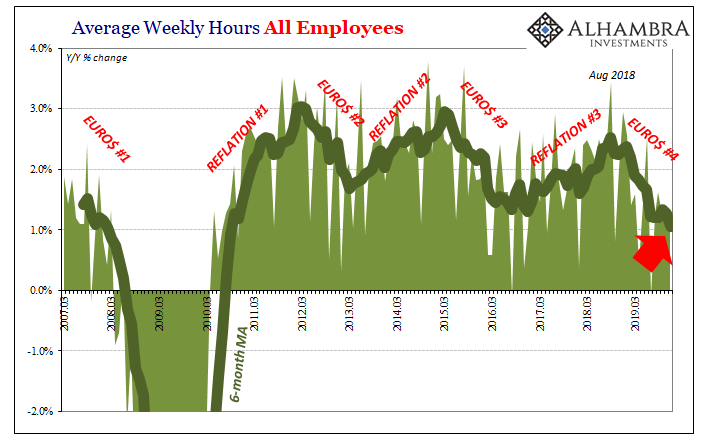
Unfortunately for the Fed Chairman, the BLS keeps reporting data inconsistent with the mainstream view; not just inconsistent, either, more and more in the wrong direction. Everyone talks about the unemployment rate and leaves it at that. The rest of the data just doesn’t line up and furthermore keeps moving downward with each new release.
I noted earlier this month how the most concerning part of the payroll reports (the Current Employment Situation, or CES) was a substantial and ongoing deceleration in total hours (above). According to the government’s numbers, US businesses just aren’t seeking to increase labor use and slowing down how much they are adding to a level we haven’t seen in these figures since 2010.
Now JOLTS. The BLS last week released estimates for Job Openings (JO) which corroborate that view (and then some). JO had been (in 2018) one of the only other data points somewhat consistent with the unemployment rate. Ever since last November, the level of Job Openings struck the same landmine that we observe in data all over the rest of the world (including CES hours).
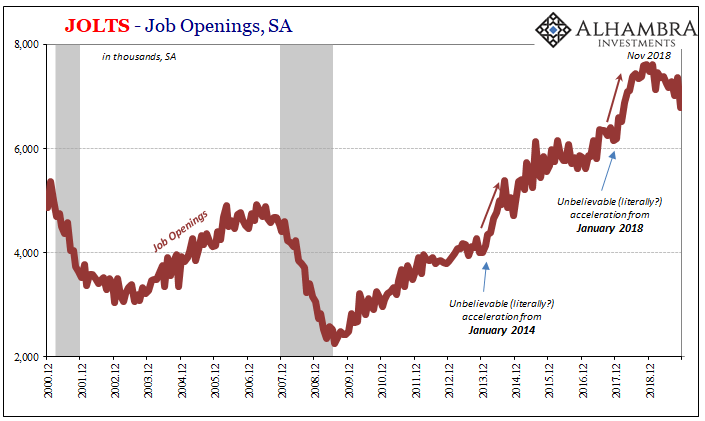
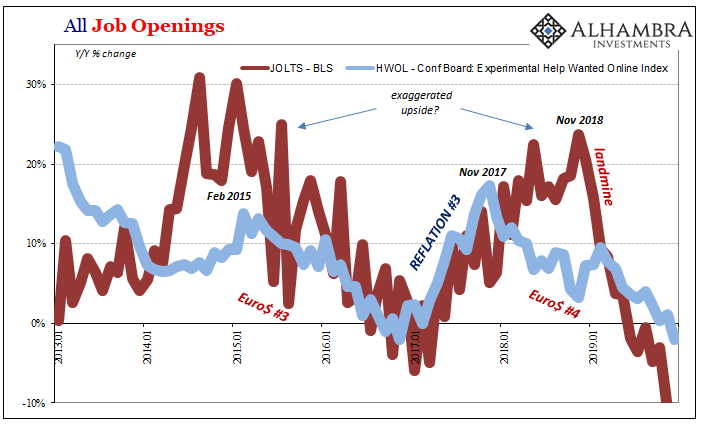

Down sharply in November 2019, at 6.8mm (seasonally adjusted) the level was more than 10% below the estimated number of job openings posted in November 2018. The JOLTS figures haven’t suggested that kind of decline since 2009 (above).
Assuming these preliminary estimates are anywhere close to accurate, what it suggests is that both US companies’ demand for labor as well as utilization of it are waning to or at extraordinary levels; meaning not just consistent with past downturns and near recessions, perhaps surpassing them.
Whether these suggest recession or not is almost beside the point. Before we get to that question, it contradicts much (if not all) of this “strong labor market” nonsense. There’s much more consistent and corroborated detail which very clearly indicate instead that the employment situation is at best going the wrong way and at worst getting there maybe a little too quickly for comfort.

And that would leave the domestic equation as something very different: a curious absence of a turnaround in global growth which raises the risks the bottom hasn’t been reached in the place where all this trouble begins; still symbolic rate cuts of little assurance let alone insurance; and a domestic labor market that is in no way strong no matter how close to zero the unemployment rate might get.
More and more this all seems to be 2017 in miniature. Back then, globally synchronized growth was basically cheerleading rather than reasonable analysis; officials making the smallest little molehill of reflation into a huge mountain of unquestionable growth. It took some time before the fallacy was fully revealed.
This time, not quite as hysterical and fevered but largely the same thing. A minor turn maybe even nothing more in the US than the American economy coming in late to this fourth synchronized global downturn, and it has all been made into the most definitively positive signals you can ask for to go along with some QE’s and rate cuts, too.
Sentiment has definitely changed, but has anything of substance?
Now January 2020 and the shine is starting to come off – a little – the pendulum of sentiment beginning to move back in the other direction. Globally synchronized growth was the hollowest of assumptions, a wafer-thin proclamation that didn’t stand up to the slightest scrutiny. It does seem like the cheerleading, at the very least, is being repeated though this time in the absence of any detectable reflation.

Stay In Touch